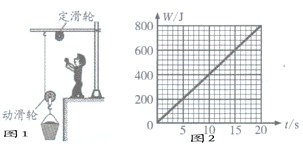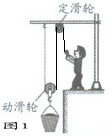小明同学用如图1所示的滑轮组提土,他用80N的拉力把重力为120N的土从井中匀速提升5m,所花时间是20s.其中拉力做功W随时间t的变化图象如图2.求:
(1)有用功
(2)滑轮组的机械效率
(3)拉力的功率
(4)为了方便把土提上来,在图1中画出滑轮组的绕线.

(1)W有=Gh=120N×5m=600J.
(2)把120N的土升高5m,用时20s,由图二知,拉力做功800J.
所以滑轮组的机械效率:η=
×100%=W有 W总
×100%=75%.600J 800J
(3)拉力功率:P=
=W总 t
=40W.800J 20s
(4)∵W=Fs,
∴绳子自由端移动的距离:s=
=W总 F
=10m,800J 80N
提升物体时绳子的段数:n=
=s h
=2,10m 5m
所以滑轮组绕法如图.

答:(1)有用功是600J.
(2)滑轮组的机械效率是75%.
(3)拉力的功率是40W.
(4)如上图.
